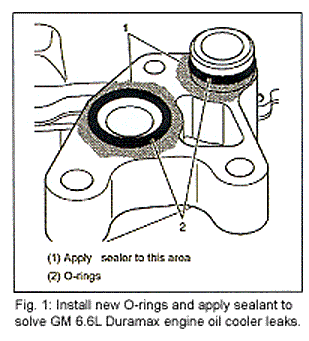Engine Builders: AERA members have reported an oil cooler leak on 2001-2004 GM 6.6L VIN 1 and 2 diesel engines. This engine is the Duramax™ used in many pickup models as well as some Topkick series vehicles.
Minor imperfections in the engine block’s machine surface at the oil cooler interface may allow engine oil seepage past the oil cooler O-rings. To cure this problem, GM offers the following information.
Inspect for other oil leaks, which may be perceived as an oil cooler leak. An oil leak from one of the main bearing cap side bolts may appear to be coming from the oil cooler.

If the oil cooler is leaking, remove the oil cooler from the engine. Use care to remove only the five bolts that hold the oil cooler to the engine block.
Remove the O-rings from the oil cooler and discard them.
Clean the mating surfaces of the engine block and the oil cooler.
Install new O-rings (2) to the oil cooler. See Figure 1.
Apply sealant (1) p/n 97720043 to the oil cooler as shown in Figure 1. Do not apply sealant to the O-ring grooves on the oil cooler.
Install the oil cooler to the engine block. Torque the five oil cooler assembly bolts to 18 ft.lbs.
Allow the vehicle to sit for 8 hours at room temperature for the sealant to fully cure before initial startup.
Engine Builders: AERA members have reported rear engine oil leaks on 1996-2004 Suzuki 1.8L and 2.0L DOHC engines. Most of those leaks have been associated with the rear crankshaft area. While the most likely source of leakage is thought to be the rear crankshaft seal, this has not been the cause of some complaints.
These engines use a crankshaft with flexplate/flywheel mounting bolt holes exposed to the crankcase. This type of design requires sealer on the bolt threads during assembly. Make sure the components and threads are clean and dry before applying a light application of thread lock, p/n 132298000-32110 to the mounting bolts. The bolts should be alternately tightened to 52 ft.lbs. Failure to apply sealer on the bolt threads may allow engine oil to seep around the bolt threads and leak externally.
Another possible cause of oil leakage on these engines has been the rear main seal, as a specific installation tool is required to maintain the seal to crankshaft alignment. More information on this is detailed in AERA Technical Bulletin TB 2109, which is available to members by calling 888-326-2372.
For information on receiving all of AERA’s regular monthly technical bulletins and other association services and benefits, call toll free 888-326-2372 or send an e-mail to [email protected]. AERA’s Web site is www.aera.org.













